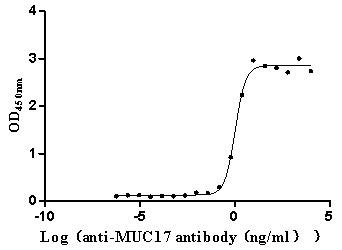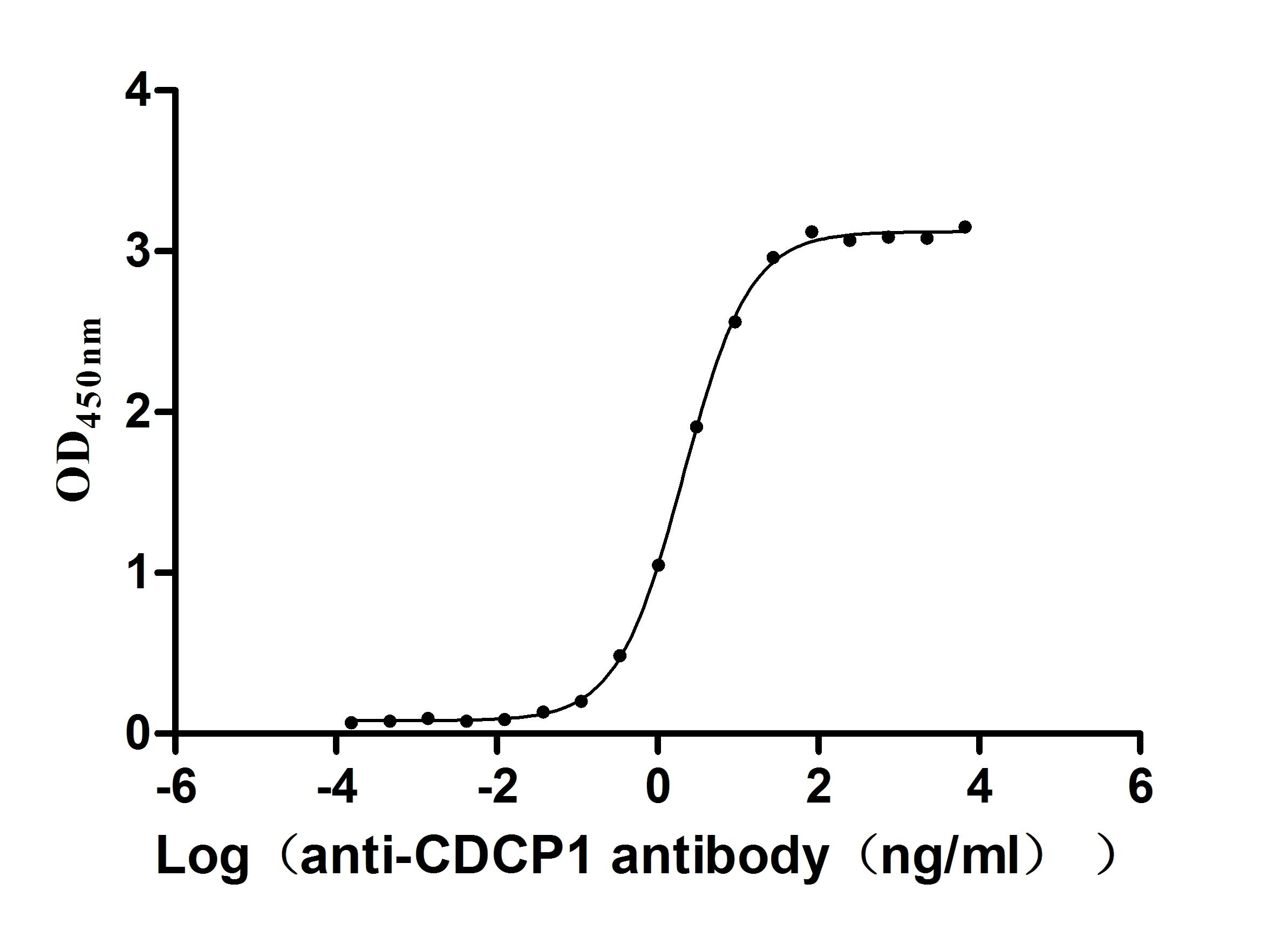Recombinant Human Glutaminase kidney isoform, mitochondrial (GLS), partial
-
中文名称:人GLS重组蛋白
-
货号:CSB-EP009528HU(F1)
-
规格:¥1836
-
图片:
-
其他:
产品详情
-
纯度:Greater than 90% as determined by SDS-PAGE.
-
基因名:
-
Uniprot No.:
-
别名:AAD20; DKFZp686O15119; FLJ10358; GAC; GAM; GLS; GLS1; GLSK_HUMAN; Glutaminase C; Glutaminase kidney isoform; Glutaminase phosphate activated; K-glutaminase; KGA; KIAA0838; L glutamine amidohydrolase; L-glutamine amidohydrolase; mitochondrial
-
种属:Homo sapiens (Human)
-
蛋白长度:Partial
-
来源:E.coli
-
分子量:33.3kDa
-
表达区域:616-669aa
-
氨基酸序列KDRWNNTPMDEALHFGHHDVFKILQEYQVQYTPQGDSDNGKENQTVHKNLDGLL
Note: The complete sequence including tag sequence, target protein sequence and linker sequence could be provided upon request. -
蛋白标签:N-terminal GST-tagged
-
产品提供形式:Liquid or Lyophilized powder
Note: We will preferentially ship the format that we have in stock, however, if you have any special requirement for the format, please remark your requirement when placing the order, we will prepare according to your demand. -
缓冲液:Tris-based buffer,50% glycerol
-
储存条件:Store at -20°C/-80°C upon receipt, aliquoting is necessary for mutiple use. Avoid repeated freeze-thaw cycles.
-
保质期:The shelf life is related to many factors, storage state, buffer ingredients, storage temperature and the stability of the protein itself.
Generally, the shelf life of liquid form is 6 months at -20°C/-80°C. The shelf life of lyophilized form is 12 months at -20°C/-80°C. -
货期:Basically, we can dispatch the products out in 1-3 working days after receiving your orders. Delivery time may differ from different purchasing way or location, please kindly consult your local distributors for specific delivery time.Note: All of our proteins are default shipped with normal blue ice packs, if you request to ship with dry ice, please communicate with us in advance and extra fees will be charged.
-
注意事项:Repeated freezing and thawing is not recommended. Store working aliquots at 4°C for up to one week.
-
Datasheet & COA:Please contact us to get it.
相关产品
靶点详情
-
功能:Catalyzes the first reaction in the primary pathway for the renal catabolism of glutamine. Plays a role in maintaining acid-base homeostasis. Regulates the levels of the neurotransmitter glutamate, the main excitatory neurotransmitter in the brain.; Lacks catalytic activity.
-
基因功能参考文献:
- Overexpressing glutaminase abolished the inhibitory effects of miR-1-3p on bladder cancer cell proliferation, migration, and invasion and glutaminase depletion resulted in the prolonged expression of gammaH2AX, an established biomarker for DNA damage. PMID: 30458442
- These results reveal that GAC is post-translationally regulated by phosphorylation, which affects cellular glutamine metabolism and glutaminase-related cell phenotype. PMID: 30092248
- In silico analysis potentially links GLS SNPs with Alzheimer disease and type 2 diabetes. PMID: 29441491
- Del11q-positive CLL lymphocytes exhibit altered glutamine metabolism and differential response to GLS1 and glucose metabolism inhibition. PMID: 29367649
- Overexpression of miR-513c suppresses neuroblastoma cells' migration, invasion, and proliferation. We demonstrate the glutaminase (GLS) is a direct target of miR-513c in human neuroblastoma cells. PMID: 28800318
- the present findings enriched our knowledge by demonstrating a significant association of PKM2 and GLS1 with oxaliplatin-resistance in CRC. PMID: 28498807
- miR-137 was decreased in melanoma tissue, and the low miR-137 levels and high glutaminase expression are independent risk factors in melanoma. miR-137 suppressed the proliferation and glutamine catabolism of melanoma cells. PMID: 29097210
- ZIC5 positively regulated the proliferation, migration (Fig. 2), and survival (Fig. 5) of PCa and CRC cells PMID: 29032577
- the crystal structure of full-length KGA and present a small-angle X-ray scattering model for full-length GLS2. These structures explain these proteins' compromised ability to assemble into catalytically active supra-tetrameric filaments, as previously shown for GAC. PMID: 28526749
- GLS1 inhibition using BPTES reduced metabolic intermediates including thymidine and carbamoyl phosphate. Reduction of thymidine and carbamoyl-phosphate synthesis by BPTES treatment exacerbated pyrimidine supply by combination with 5-FU, which induced cell death synergistically in NSCLC PMID: 27338638
- studies show that the formation of large GAC oligomers is not a pre-requisite for full enzymatic activity. They also offer a mechanism by which the binding of activators like inorganic phosphate enables the activation loop to communicate with the active site to ensure maximal rates of catalysis, and promotes the opening of the lid to achieve optimal product release. PMID: 27542409
- Glutaminase expression in tumor cells was significantly associated with a low level of tumor-infiltrating lymphocytesand poor disease-free survival in triple-negative breast cancers presenting with lymph node metastasis and high levels of tumor-infiltrating lymphocytes. PMID: 28185053
- Study reports that GLS1 is a direct target of miR-23a in retinal pigment epithelium cells (RPE) providing evidence for a role in maintaining RPE cell function. PMID: 27411920
- The relative expression of microRNA-153 and glutaminase in glioblastoma versus matched non-tumor tissues showed a reverse correlation, further indicating that microRNA-153 may negatively regulate glutaminase in vivo. PMID: 28218035
- High GLS1 expression is associated with epithelial-mesenchymal transition in cancer. PMID: 26771232
- Data suggest that glutaminase C (GAC) inhibition maybe a potential treatment strategy for acquired erlotinib-resistant non-small cell lung cancer (NSCLC). PMID: 26575584
- Findings indicate a role for transcription factor c-Jun as a driver of cancer cell metabolic reprogramming, and suggest that cancers overexpressing JUN may be especially sensitive to glutaminase (GLS)-targeted therapies. PMID: 27089238
- GLS1 was identified as a potential downstream target of the miR-192/-204-HOTTIP axis in hepatocellular carcinoma. PMID: 26710269
- Our findings support the role of the GLS long microsatellite in the development of HE; this could be important for identifying susceptible patients and for the prevention of this condition. PMID: 25880019
- GABAergic neurons and astrocytes express Gls and Gls2 isoenzymes in nucleus and mitochondria, in addition to glutamatergic neurons PMID: 25297978
- studies demonstrate that GLS is required for tumorigenesis and support small molecule and genetic inhibition of GLS as potential approaches for targeting the tumor cell-autonomous dependence on GLS for cancer therapy. PMID: 25915584
- GLS1 has a key role in coupling glutaminolysis of the TCA cycle with elevated glucose uptake and consequently the growth of prostate cancer cells PMID: 25482439
- These results suggest that the expression of GLS1 is upregulated and correlates with clinicopathological factors in colorectal cancer. PMID: 24696726
- Silencing GLS or overexpressing GLS2 induces growth inhibition in glioma cell lines. PMID: 24276018
- our data indicate that ErbB2 activation promotes GLS1 expression via a PI3K-Akt-independent NF-kappaB pathway in breast cancer cells, identifying another oncogenic signaling pathway which stimulates GLS1 expression PMID: 24122876
- The rate of Glu decarboxylation into GABA by Glnase is an order of magnitude lower than that of Glutamate decarboxylase. Potential impact on the mechanistic aspects of Gln-Glu shuttle in neuroscience and glutaminolysis in tumors, is discussed. PMID: 24755074
- STAT1 regulates human glutaminase 1 promoter activity PMID: 24086752
- Inhibition of glutaminase selectively suppresses the growth of primary acute myeloid leukemia cells with IDH mutations. PMID: 24333121
- A glutaminase inhibitor reduced conversion of (13)C-pyruvate to alanine. PMID: 23722553
- HER2- type breast cancer had the highest expression of stromal GLS1, tumoral GDH, stromal GDH, and tumoral ASCT, while TNBC had the lowest tumoral GDH expression. PMID: 23507704
- activated glutaminase C (GAC) self-assembles into a helical, fiber-like double-stranded oligomer and propose a molecular model consisting of seven tetramer copies per turn per strand interacting via the N-terminal domains PMID: 23935106
- stromal expression of the glutamine-metabolism-related proteins GLS1, GDH, ASCT2 increases with worsening histological phyllodes tumor grade. PMID: 23636801
- neuronal glutaminase is a potential component of neurotoxicity during inflammation and modulation of glutaminase may provide therapeutic avenues for neurodegenerative diseases. PMID: 23578284
- NSCLC cell lines depend on Gln for glutaminolysis to a varying degree, in which the GLS1 splice variant GAC plays an essential role and is a potential target for cancer metabolism-directed therapy. PMID: 22892846
- Data indicate that both HIV-1 infection and IFN-alpha treatment increase glutaminase 1 (GLS1) expression through STAT1 phosphorylation and by binding to the GLS1 promoter. PMID: 22479354
- KGA activity in cells is stimulated by EGF, and KGA associates with all three kinase components of the Raf-1/Mek2/Erk signaling module. PMID: 22538822
- Inhibition of Gls1 kills lung cancer cells that overexpress MYC and catabolize glutamine. PMID: 22326218
- GLS1 differs from PFKFB3 in that its recognition by APC/C-Cdh1 during S phase requires the presence of both a Lys-Glu-Asn box (KEN box) and a destruction box (D box) rather than a KEN box alone. PMID: 22106309
- first report of full-length crystal structure of a splice variant of GLS1 in presence/absence of BPTES, an allosteric inhibitor: 2 BPTES molecules bind at interface of GLS1 tetramer; appear to lock GLS1 tetramer into nonproductive conformation PMID: 22049910
- Glutamine synthetase is a genetic determinant of cell type-specific glutamine independence in breast epithelia PMID: 21852960
- This studt demonistrated that the genetic variation in the glutaminase gene GLS1 is related the glutamine/glutamate ratio in brain. PMID: 21457947
- Glutaminase: a hot spot for regulation of cancer cell metabolism. PMID: 21234284
- Data show that the ability to selectively slow growth in cells with IDH1 mutations by inhibiting glutaminase suggesting a unique reprogramming of intermediary metabolism and a potential therapeutic strategy. PMID: 21045145
- This study identifies mutations in the gene sequence for glutaminase that are associated with development of hepatic encephalopathy in patients with cirrhosis PMID: 20820037
- Data suggest that glutaminase is an important factor in melanoma cell proliferation. PMID: 12579526
- human neutrophils appeared to utilize glutamine and posess the appropriate glutaminase enzyme for metabolizing glutamine. PMID: 14722097
- possible role for intestinal glutaminase in the pathogenesis of hepatic encephalopathy PMID: 15246207
- K glutaminase isoform is up-regulated with increased rates of proliferation in cancer cells, whereas prevalence of the L isoform seems to be related with resting or quiescent cell states PMID: 15496140
- c-Myc transcriptionally represses miR-23a and miR-23b, resulting in greater expression of their target protein, mitochondrial glutaminase, in human P-493 B lymphoma cells and PC3 prostate cancer cells PMID: 19219026
- Release of glutaminase from dysfunctional macrophages is a possible mechanism of glutaminase-mediated production of excitotoxic glutamate during the pathogenic process of human immunodeficiency virus (HIV)-1 associated dementia. PMID: 19222703
显示更多
收起更多
-
亚细胞定位:[Isoform 1]: Mitochondrion. Cytoplasm, cytosol.; [Isoform 3]: Mitochondrion.; [Glutaminase kidney isoform, mitochondrial 68 kDa chain]: Mitochondrion matrix.; [Glutaminase kidney isoform, mitochondrial 65 kDa chain]: Mitochondrion matrix.
-
蛋白家族:Glutaminase family
-
组织特异性:Isoform 1 and isoform 3 are detected in brain cortex. Isoform 3 is highly expressed in astrocytoma, ganglioglioma and ependymoma. Isoform 1 is highly expressed in brain and kidney, but not detected in liver. Isoform 3 is highly expressed in heart and panc
-
数据库链接:
HGNC: 4331
OMIM: 138280
KEGG: hsa:2744
STRING: 9606.ENSP00000317379
UniGene: Hs.116448
Most popular with customers
-
Recombinant Human Intestinal-type alkaline phosphatase (ALPI) (Active)
Express system: Mammalian cell
Species: Homo sapiens (Human)
-
Recombinant Human Mucin-17 (MUC17), partial (Active)
Express system: Mammalian cell
Species: Homo sapiens (Human)
-
Recombinant Human Carcinoembryonic antigen-related cell adhesion molecule 6 (CEACAM6) (Active)
Express system: Mammalian cell
Species: Homo sapiens (Human)
-
Recombinant Macaca fascicularis lymphocyte antigen 6 family member G6D (LY6G6D) (Active)
Express system: Yeast
Species: Macaca fascicularis (Crab-eating macaque) (Cynomolgus monkey)
-
Recombinant Human Cell adhesion molecule 1 (CADM1), partial (Active)
Express system: Mammalian cell
Species: Homo sapiens (Human)
-
Recombinant Macaca fascicularis CUB domain containing protein 1 (CDCP1), partial (Active)
Express system: Mammalian cell
Species: Macaca fascicularis (Crab-eating macaque) (Cynomolgus monkey)
-
Recombinant Human B- and T-lymphocyte attenuator(BTLA), partial (Active)
Express system: Mammalian cell
Species: Homo sapiens (Human)
-
Recombinant Human Cadherin-1(CDH1),partial (Active)
Express system: Mammalian cell
Species: Homo sapiens (Human)

-SDS.jpg)



















